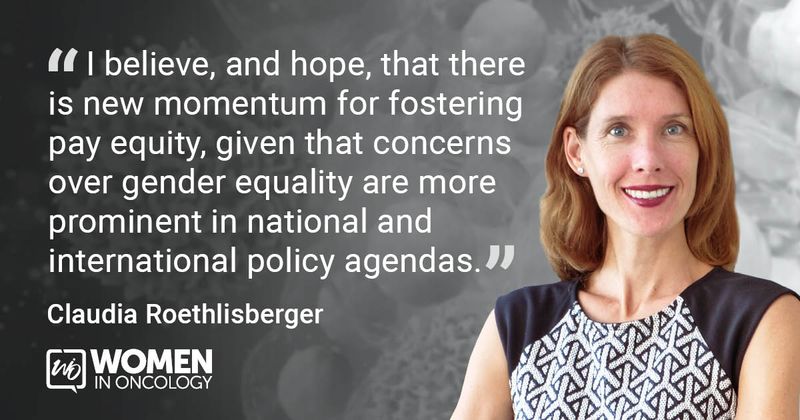Personality traits, social norms may contribute to gender wage gap
Although personality traits and social norms appeared to be key factors in the gender wage gap, their precise contributions were unclear, according to study results published in Journal of Economic Surveys.
Findings from the study suggest that the literature is not conclusive on whether these factors account for the gender wage gap or are a source of discrimination, researchers noted.

“I believe, and hope, that there is new momentum for fostering pay equity, given that concerns over gender equality are more prominent in national and international policy agendas,” Claudia Roethlisberger, research/PhD fellow at Maastricht University in the Netherlands, told Healio. “However, the COVID-19 pandemic has reversed some of the precious gains achieved in this area. Pay equity is an important aspect of gender equality but difficult to achieve as having more equal opportunities for women means that some men will need to wait, which is not easy. Not everybody can win — at least in the short term.”
Roethlisberger and colleagues assessed the literature on the contribution of personality traits and social norms to the gender wage gap. They systematically reviewed 39 published studies on the topic and found that both determinants are significant in understanding the wage gap but found no clear consensus on the constructs, what they capture and how to measure them.
Roethlisberger spoke with Healio about her research on the gender wage gap, the findings that surprised her and the policy interventions she and other studies recommend to close the wage gap.
Healio: What was the rationale for this study?
Roethlisberger: Throughout my career, I have observed that women tend to progress slower than men in their careers. Even in an institutional setting where women and men have similar work experience and educational backgrounds, the pace of career progression appears to be different. I was puzzled by how persistent this problem is, even in a time when women and men tend to be become more similar in terms of career aspirations and many more men are supportive of the careers of their partners. The curiosity was thus to explore more subtle factors that hold women back, such as social norms and personality traits.
Healio: What are the key findings?
Roethlisberger: We found that, indeed, personality traits and social norms can be important in understanding the gender wage gap, but that there is a great deal of heterogeneity in the results. There is no clear consensus on the constructs of traits and norms, what they precisely capture and how to measure them. There is a large range in terms of the contribution of traits and norms to the gap — ranging from a few to more than 20%. When decomposing the gap, we found that the literature is not conclusive on whether these factors explain the gap or are a source of discrimination.
Healio: Did any of your findings surprise you?
Roethlisberger: During the revision process, I realized how sensitive this area of research is and that we have to be very mindful of its limitations when interpreting results. For instance, most studies included in the systematic review used statistical methods to identify if there are significant gender differences in traits and norms. This approach results in averages — thus, stereotyping. This was a concern in the review process and showed that it was important to go further and look at the size of the difference and distributions because otherwise it could lead to misguided stereotyping.
I also would have expected that there would be a clearer association between personality traits/social norms and discrimination, meaning that men and women are not treated equally with respect to their traits and norms. This is a bit troubling because it puts much responsibility on women, suggesting that they, on average, have less productive traits and attitudes.
Healio: What should our women oncologist readers now do with this information?
Roethlisberger: Speaking in more general terms on what the underlying papers of our study suggest in terms of policy interventions to close the pay gap, the papers identify policy intervention in three main domains. The first relates to the need for changing social or cultural norms that goes beyond the laws for nondiscrimination. Laws are important but not sufficient. Changes in norms, attitudes and preferences are also needed.
The second domain concerns policies to better balance household and market roles. This requires family-friendly policies to reduce gender differences in and expectations about labor market engagement, such as flexible work hours and practices available for both genders.
The third domain relates to policies that can support women in adapting their skills and behavior. Here, an important question is, to what extent can women and men adapt their personality and attitudes during their careers? And, how stable or malleable are our personality and attitudes?
Healio: What’s next?
Roethlisberger: As a next step of this research, we carried out an empirical analysis of the contribution of personality traits to the gender wage gap in Switzerland to gather more evidence on the contribution. Switzerland offers an interesting case because women’s participation in the labor market has changed considerably in the recent past. We found that one dimension in particular, neuroticism, can contribute to explaining the gap, but that traits are no source of wage discrimination. The results are thus in line with the systematic literature review. Currently, we are working on exploring the contribution of social norms to the gender wage gap, focusing on an afterschool care policy which came into effect to support women’s labor market participation.
Healio: Is there anything else that you would like to mention?
Roethlisberger: Several countries have recently adopted mechanisms and policies to secure and enforce long-standing laws of equal pay for equal work. At the United Nations, the commitment for gender equality is reflected in the Sustainable Development Goals, and our Secretary-General has appointed a gender-balanced top management. But still, much work remains to be done as gender equality remains a dream in most societies.
For more information:
Claudia Roethlisberger can be reached c.rothlisberger@student.maastrichtuniversity.nl.

